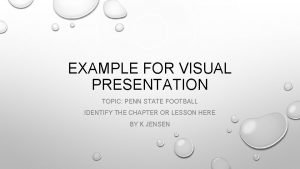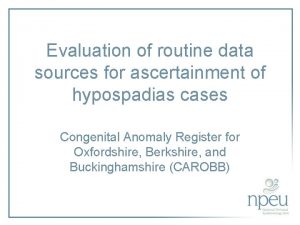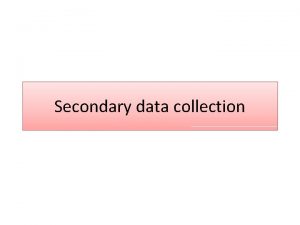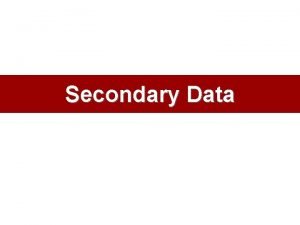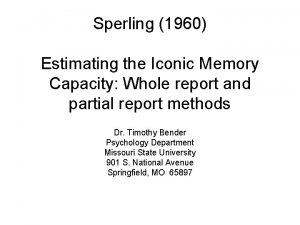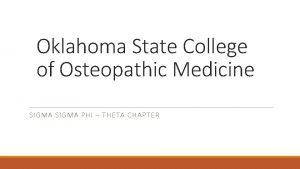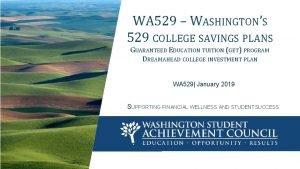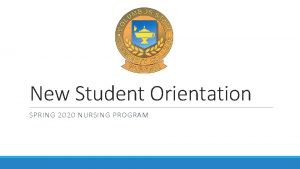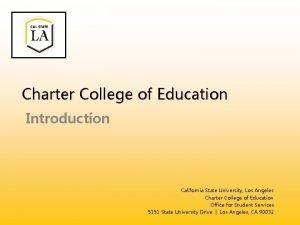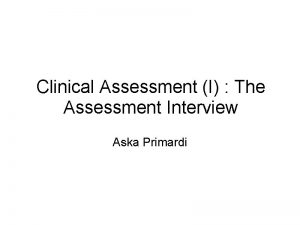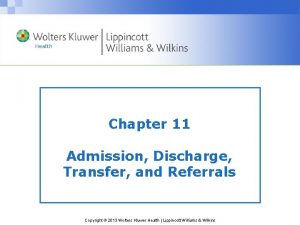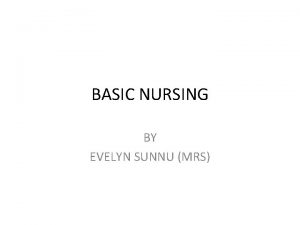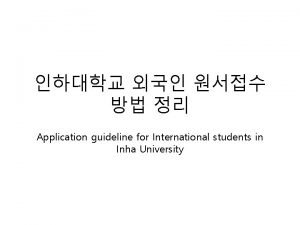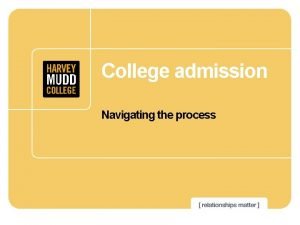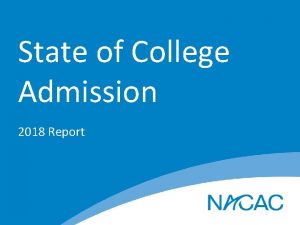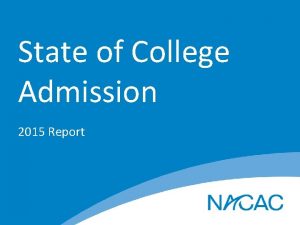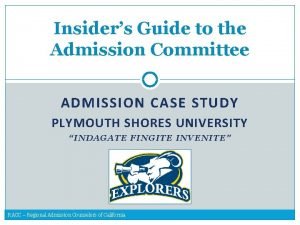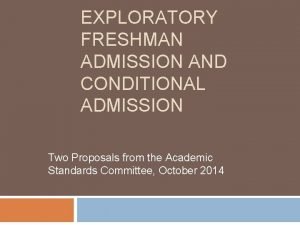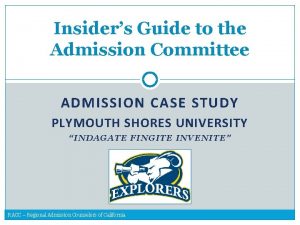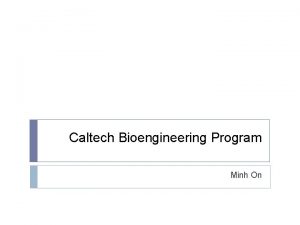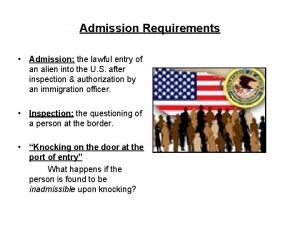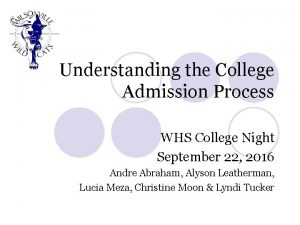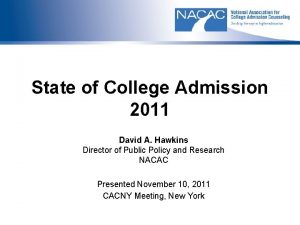State of College Admission 2017 Report Data Sources











































- Slides: 43

State of College Admission 2017 Report

Data Sources • NACAC annual surveys – Counseling Trends Survey – Admission Trends Survey • External Data – US Department of Education IPEDS data – Other education organizations

Methodology Admission Trends Survey (Fall 2016 Cycle) – Two surveys: 1) university admission offices 2) institutional research offices – Surveyed 1, 383 NACAC member colleges – Received 604 responses overall (127 institutions submitted both sections, 202 submitted only the admission office sections, and 275 submitted only the IR portion) – 44% response rate

Methodology (con’t) 2016 -17 Counseling Trends Survey – Surveyed NACAC member secondary schools plus random sample of all public high schools (11, 139 total) – 2, 266 usable responses – Survey respondents over-representative of public schools; larger proportion of students eligible for free-or-reduced priced lunch; and larger enrollments compared to all secondary schools

College Applications

Number of High School Graduates: Actual and Projected, 1990 to 2027 4000 Number of students (thousands) 3500 3000 2500 2000 1500 1990 -91 1995 -96 2000 -01 2005 -06 2010 -11 2015 -16 2020 -21 2025 -26 Note: Includes both public and private high school graduates. Source: US Department of Education, National Center for Education Statistics (2017). Digest of Education Statistics. Table 219. 10. Washington DC: NCES

Actual and Projected Numbers of Public High School Graduates, by Region: 1999– 00, 2009– 10 and 2026– 27 (in thousands) 1, 400 1, 311 1, 139 1, 000 861 714 648 555 600 761 799 693 591 524 454 200 Northeast Midwest 1999 -00 South 2012 -13 West 2026 -27 (projected) Source: US Department of Education, National Center for Education Statistics. (2016). Digest of Education Statistics. Table 219. 20. Washington DC: NCES.

Increases in Student Application Submission: 1990 to 2016 (First-Time Freshmen) 90% 80% 70% 67% 61% 71% 74% 75% 77% 79% 77% 81% 83% 82% 35% 36% 35% 2014 2015 2016 61% 60% 50% 40% 30% 20% 10% 9% 10% 1990 1995 13% 17% 18% 19% 2005 2006 2007 22% 23% 25% 2008 2009 2010 29% 28% 2011 2012 32% 0% 2000 Submitted 3 or more applications 2013 Submitted 7 or more applications Source: Eagan, K. , Stolzenberg, E. B. , Zimmerman, H. B. , Aragon, M. C. , Sayson, H. W. , & Rios-Aguilar, Rios. (2017). The American Freshman: National Norms Fall 2016. Los Angeles: Higher Education Research Institute at UCLA. Eagan, M. K. , Stolzenberg, E. B. , Ramirez, J. J. , Aragon, M. C. , Suchard, M. R. , and Rios-Aguilar, C. (2016). The American Freshman: Fifty-Year Trends, 1996 -2015. Los Angeles: Higher Education Research Institute, UCLA.

Applications and Enrollment, by Selectivity: Fall 2015 (First-Time Freshmen) Average Acceptance Rate for Four-Year Colleges: 66. 1 percent National share of institutions Average number of applications per institution National share of applications National share of full-time, freshmen undergraduates 19. 2% 11, 924 36. 7% 21. 5% 50 to 70 percent 35. 9% 5, 772 33. 3% 34. 7% 71 to 85 percent 28. 7% 5, 032 23. 2% 31. 1% More than 85 percent 16. 3% 2, 589 6. 8% 12. 8% Selectivity Accept fewer than 50 percent of applicants Source: US Department of Education, National Center for Education Statistics. (2015 -16). Integrated Postsecondary Education Data System (IPEDS) Data Center. Washington, DC: NCES. [Includes Title-IV participating, four-year public and private not-for-profit, degree-granting (primarily baccalaureate) institutions in the US that enroll first-time freshman and are not open admission. ]

Growth in Applications Fall 2015 to Fall 2016 Percent Change First-Time Freshmen 7% Transfer Students 1% International Students 13% Source: NACAC Admission Trends Survey, 2016

Acceptance Rates for Transfer and International Applicants Mean TRANSFER Transfer Selectivity Rate 62. 1% Freshman Selectivity Rate for Institutions with Transfer Students 66. 0% INTERNATIONAL International Selectivity Rate 54. 5% Freshman Selectivity Rate for Institutions with International Students 66. 3% Source: NACAC Admission Trends Survey, 2016

College Application Fees (First-Time Freshmen) Percentage with Fees Mean Fee 78. 5% $47. 62 Public 96. 2 $48. 24 Private 66. 7 $47. 03 Type Enrollment Fewer than 3, 000 students 65. 2 $41. 64 3, 000 to 9, 999 90. 4 $50. 13 10, 000 or more 95. 6 $56. 23 90. 7 $58. 75 50 to 70 percent 70. 8 $45. 45 71 to 85 percent 82. 1 $45. 25 More than 85 percent 78. 4 $40. 50 Selectivity Accept fewer than 50 percent of applicants Source: NACAC Admission Trends Survey, 2016

Recruitment and Yield Strategies

Importance of Prospective Student Populations in Meeting Institutional Enrollment Goals 80. 0% 70. 0% 68. 6% 60. 0% 50. 0% 38. 9% 40. 0% 32. 6% 27. 5% 30. 0% 20. 1% 20. 0% 10. 3% 10. 0% 1. 0% 0. 0% Transfer Students (N=194) Considerable Importance Source: NACAC Admission Trends Survey, 2016 1. 0% International Students (N=193) Moderate Importance Limited Importance No Importance

Average Yield Rates, by Prospective Student Group Average First-Time Freshmen Yield Rate for All Four-Year Colleges: 35. 1 percent Mean TRANSFER Transfer Yield Rate 65. 2% Freshman Yield Rate for Institutions with Transfer Students 27. 6% INTERNATIONAL International Yield Rate 31. 7% Overall Freshman Yield Rate for Institutions with International Students 27. 7% Sources: NACAC Admission Trends Survey, 2016 US Department of Education, National Center for Education Statistics. (2015 -16). Integrated Postsecondary Education Data System (IPEDS) Data Center. Washington, DC: NCES.

Importance of Various Recruitment Strategies First-Time Freshmen Percentage of Colleges Rating As: Website E-mail Hosted Campus Visit High School Counselor High School Visit Direct Mail College Fairs Social Media Community Based Organizations Test-Optional Policy Alumni Conditional/Provisional Admission Program Source: NACAC Admission Trends Survey, 2016 Considerably Important Moderately Important Limited Importance Not Important 87. 6% 79. 7 76. 2 57. 3 54. 9 50. 5 41. 7 40. 0 20. 2 15. 3 12. 1 9. 7% 18. 7 18. 9 38. 4 37. 5 31. 9 41. 7 41. 6 37. 2 7. 6 31. 2 2. 5% 1. 6 3. 8 4. 3 7. 6 16. 0 15. 5 18. 4 38. 8 5. 9 47. 3 0. 5% 0. 0 1. 1 0. 0 1. 6 1. 1 0. 0 3. 8 71. 2 9. 0 3. 9 21. 3 30. 9 43. 8

Importance of Various Recruitment Strategies Transfer Students Percentage of Colleges Rating As: Considerably Important Moderately Important Limited Importance Not Important Website 86. 0 10. 7 2. 8 0. 6 E-mail 72. 1 19. 6 6. 7 1. 7 Community College Outreach/Partnership 61. 8 24. 7 9. 0 4. 5 Articulation Agreements with Community Colleges 57. 4 23. 9 9. 7 9. 1 Hosted Campus Visit 55. 6 23. 6 14. 0 6. 7 Social Media 32. 2 36. 7 28. 2 2. 8 Direct Mail 25. 0 27. 2 37. 2 10. 6 College Fairs 19. 7 37. 6 33. 7 9. 0 High School Counselor 15. 4 13. 6 32. 0 39. 1 High School Visit (in the US) 9. 8 10. 4 16. 6 63. 2 Test-Optional Policy 9. 8 4. 3 8. 6 77. 3 Alumni 9. 2 19. 0 56. 9 14. 9 Community Based Organizations 3. 4 22. 9 47. 4 26. 3 Conditional/Provisional Admission Program 2. 4 14. 2 23. 7 59. 8 High School Visit (Outside the US) 0. 6 4. 4 7. 6 87. 3 Source: NACAC Admission Trends Survey, 2016

Importance of Various Recruitment Strategies International Students Percentage of Colleges Rating As: Considerably Important Moderately Important Limited Importance Not Important Website 88. 1 8. 5 2. 8 0. 6 E-mail 78. 5 16. 9 4. 0 0. 6 High School Counselor 36. 1 24. 9 14. 2 Social Media 35. 6 36. 2 25. 9 2. 3 Hosted Campus Visit 30. 4 13. 5 32. 7 23. 4 High School Visit (outside the US) 19. 4 25. 1 28. 0 27. 4 Partnerships with International Colleges 16. 4 27. 9 College Fairs 15. 5 28. 2 38. 5 17. 8 International Student Recruitment Agents 12. 6 26. 8 19. 7 41. 0 Test-Optional Policy 11. 8 1. 9 8. 1 78. 3 Federal Government Support 11. 7 22. 2 27. 8 38. 3 Foreign Government Support 11. 1 27. 8 25. 6 35. 6 Alumni 11. 1 25. 1 50. 9 12. 9 Conditional/Provisional Admission Program 10. 3 17. 6 28. 5 43. 6 High School Visit (in the US) 9. 8 14. 0 31. 1 45. 1 State or Regional Recruitment Consortium 4. 5 25. 4 30. 5 39. 5 Direct Mail 2. 8 11. 4 46. 0 39. 8 Source: NACAC Admission Trends Survey, 2016

Key Statistics for Early Decision (ED) Colleges Mean Applications Received through Early Decision 5. 8% Early Decision Selectivity Rate 59. 5% Overall Selectivity Rate for Institutions with Early Decision Policies 47. 9% Early Decision Yield Rate 86. 6% Overall Yield Rate for Institutions with Early Decision Policies 25. 2% Source: NACAC Admission Trends Survey, 2016

Key Statistics for Early Action (EA) Colleges Mean Applications Received through Early Action 43. 2% Early Action Selectivity Rate 71. 1% Overall Selectivity Rate for Institutions with Early Action Policies 65. 2% Early Action Yield Rate 24. 8% Overall Yield Rate for Institutions with Early Action Policies 23. 3% Source: NACAC Admission Trends Survey, 2016

Percentage of Colleges Using Early Decision, Early Action, and Wait Lists Early Decision Early Action Wait List 20. 3% 34. 0% 39. 1% Public 5. 1 26. 1 30. 8 Private 30. 4 39. 3 44. 7 Fewer than 3, 000 students 25. 1 31. 5 33. 3 3, 000 to 9, 999 20. 8 39. 0 44. 4 10, 000 or more 5. 9 33. 8 48. 5 Accept fewer than 50 percent of applicants 49. 3 29. 3 72. 0 50 to 70 percent 21. 6 38. 4 39. 6 71 to 85 percent 9. 8 39. 0 30. 1 More than 85 percent 0. 0 19. 1 12. 0 All Survey Respondents Type Enrollment Selectivity Source: NACAC Admission Trends Survey, 2016

Mean Percentage of Students Admitted From a Wait List These acceptance rates are based on the group of students who opt to remain on a wait list, which was only 48 percent, on average. Mean Percentage All Survey Respondents Selectivity Accept fewer than 50 percent of applicants Source: NACAC Admission Trends Survey, 2016 31. 9 14. 1

Factors in the Admission Decision

Importance of Various Factors in the Admission Decision: First-Time Freshmen Percentage of Colleges Rating As: Considerably Important Moderately Important Limited Importance Not Important 12. 5% 9. 3% 1. 4% Grades in College Prep Courses 76. 9% Grades in All Courses 77. 1 13. 8 6. 4 2. 8 Strength of Curriculum 51. 8 35. 3 7. 3 5. 5 Admission Test Scores (SAT, ACT) 54. 3 27. 9 13. 7 4. 1 Essay or Writing Sample 18. 9 35. 9 22. 1 23. 0 Counselor Recommendation 14. 6 46. 0 25. 8 13. 6 Student’s Demonstrated Interest 13. 7 25. 5 32. 1 28. 8 Teacher Recommendation 10. 9 46. 4 28. 0 14. 7 Class Rank 9. 2 24. 0 34. 6 32. 3 Subject Test Scores (AP, IB) 6. 9 30. 6 31. 9 Portfolio 6. 2 5. 7 27. 6 60. 5 Extracurricular Activities 7. 9 36. 0 36. 9 19. 2 SAT II Scores 2. 4 6. 1 21. 2 70. 3 Interview 4. 7 17. 4 31. 9 46. 0 State Graduation Exam Scores 1. 9 7. 6 21. 9 68. 6 Work 2. 8 15. 6 47. 4 34. 1 Source: NACAC Admission Trends Survey, 2016

Correlation Matrix: Institutional Characteristics and Importance of Admission Decision Factor (First-time Freshmen) Grades in College Prep Courses Strength of Curriculum Admission Test Scores Essay/ Writing Sample Private Institution . 17* . 14* -. 16* . 33** Enrollment -. 07 . 06 . 13 -. 22* Selectivity -. 20 -. 41** Yield -. 17 -. 04 -. 15. 33** Notes: N = 209, Spearman’s Rho correlation coefficients were calculated. * p <. 05, ** p <. 01 Source: NACAC Admission Trends Survey, 2016 -. 21* -. 15

Differences in Admission Factor Ratings by Institution Type (First-Time Freshmen) Institution Type – Private: More importance on grades in college prep courses, strength of curriculum, and essay/writing sample – Public: More importance on admission test scores Enrollment Size – Smaller: More importance on essay/writing sample Acceptance Rate – More Selective: More importance to strength of curriculum and essay/writing sample Source: NACAC Admission Trends Survey, 2016

Importance of Various Factors in the Admission Decision: Transfer Students Percentage of College Rating As: Considerably Important Moderately Important Limited Importance Not Important Overall GPA at Prior Postsecondary Institution(s) 80. 8 10. 1 6. 6 2. 5 Average Grades in Transferable Courses 75. 3 16. 2 5. 1 3. 5 High School Grade Point Average 14. 4 25. 4 44. 3 15. 9 Strength of High School Curriculum 10. 5 24. 0 37. 5 28. 0 Essay or Writing Sample 15. 1 27. 6 30. 2 Articulation with Prior Postsecondary Institution 17. 3 29. 9 23. 9 28. 9 Grades in College Prep Courses in high school 14. 7 27. 4 37. 1 20. 8 Teacher Recommendation 8. 2 35. 6 30. 9 25. 3 Student’s Demonstrated Interest 12. 8 20. 5 33. 3 Quality of Postsecondary Institution 10. 2 30. 6 38. 8 20. 4 Counselor Recommendation 6. 6 26. 0 34. 2 33. 2 Admission Test Scores (SAT, ACT) 7. 5 16. 0 44. 0 32. 5 Extracurricular Activities 5. 1 19. 8 46. 2 28. 9 Portfolio 6. 7 4. 7 25. 4 63. 2 Interview 3. 6 14. 9 28. 7 52. 8 State Graduation Exam Scores 0. 0 1. 5 18. 0 80. 4 Work 2. 6 13. 8 49. 5 34. 2 High School Class Rank 1. 0 8. 5 19. 6 70. 9 SAT II scores 0. 0 3. 1 15. 9 81. 0 Subject Test Scores (AP, IB) 2. 5 15. 6 27. 1 54. 8 Source: NACAC Admission Trends Survey, 2016

Importance of Various Factors in the Admission Decision: International Students Percentage of Colleges Rating As: Considerably Important Moderately Important Limited Importance Not Important 16. 1% 1. 0% 2. 6% English Proficiency Exam Scores 80. 3% Grades in College Prep Courses 66. 2 20. 5 9. 2 4. 1 Grades in All Courses 66. 3 21. 4 9. 7 2. 6 Strength of Curriculum 46. 9 33. 2 10. 7 9. 2 Admission Test Scores (SAT, ACT) 36. 5 27. 9 24. 4 11. 2 Essay or Writing Sample 23. 4 32. 5 21. 8 22. 3 National School Leaving or Graduation Certificate 28. 3 24. 4 21. 1 Counselor Recommendation 13. 6 41. 9 24. 1 26. 1 Teacher Recommendation 10. 6 43. 9 27. 0 18. 5 Subject Test Scores (AP, IB) 6. 6 31. 1 25. 0 37. 2 Student’s Demonstrated Interest 14. 1 25. 7 31. 4 28. 8 Class Rank 6. 1 16. 8 31. 6 45. 4 Interview 8. 4 16. 2 29. 8 45. 5 Portfolio 5. 7 6. 3 26. 0 62. 0 Extracurricular Activities 6. 2 30. 4 39. 7 23. 7 SAT II Scores 2. 6 6. 7 20. 2 70. 5 Work 2. 1 11. 5 46. 1 40. 3 Note: -- = No institutions in category; Source: NACAC Admission Trends Survey, 2016

First-Time Freshmen Factors: Trends Percentage of Colleges Rating As Considerably Important 2006 2007 2008 2009 2010 2011 2012 2013 2014 2015 2016 76% 80% 75% 87% 83% 84% 82% 79% -- 77% Strength of Curriculum 62 64 62 71 66 68 65 64 60 -- 52 Admission Test Scores 60 59 54 58 59 59 56 58 56 -- 54 Grades in All Courses 51 52 52 46 46 52 50 52 60 -- 77 Essay or Writing Sample 28 26 27 25 20 22 22 -- 19 Class Rank 23 23 19 16 22 19 13 15 14 -- 9 Counselor Recommendation 21 21 20 17 19 19 16 16 17 -- 15 Demonstrated Interest 21 22 21 21 23 21 18 20 17 -- 14 Teacher Recommendation 20 21 21 17 19 17 15 14 15 -- 11 Interview 10 11 11 7 9 6 7 8 4 -- 5 Extracurricular Activities 8 7 7 9 7 5 7 10 6 -- 8 Work 3 2 2 2 1 3 1 -- 3 Subject Test Scores (AP, IB) 8 7 10 7 5 8 7 -- 7 State Graduation Exams 6 4 4 3 4 4 2 3 4 -- 2 SAT II Scores 5 6 7 5 5 5 4 6 5 -- 2 Portfolio -- -- 7 8 6 7 5 6 7 -- 6 Grades in College Prep Courses -- Not available. Source: NACAC Admission Trends Survey, 2016

Percentage of Colleges Attributing “Considerable Importance” to Factors in the Admission Decision: Comparison of Prospective Student Groups First-Time Freshmen Transfer Students 14. 7% International Students 66. 2% Grades in College Prep Courses Taken in High School 76. 9% Grades in All High School Courses 77. 1 14. 4 66. 3 Strength of High School Curriculum 51. 8 10. 5 46. 9 Admission Test Scores (SAT, ACT) 54. 3 7. 5 36. 5 Essay or Writing Sample 18. 9 15. 1 23. 4 Counselor Recommendation 14. 6 6. 6 13. 6 Student’s Demonstrated Interest 13. 7 12. 8 14. 1 Teacher Recommendation 10. 9 8. 2 10. 6 Class Rank 9. 2 1. 0 6. 1 Subject Test Scores (AP, IB) 6. 9 2. 5 6. 6 Portfolio 6. 2 6. 7 5. 7 Extracurricular Activities 7. 9 5. 1 6. 2 SAT II Scores 2. 4 0. 0 2. 6 Interview 4. 7 3. 6 8. 4 State Graduation Exam Scores 1. 9 0. 0 n/a Work 2. 8 2. 6 2. 1 Source: NACAC Admission Trends Survey, 2016

Student Contextual Factors Student characteristics that may influence how the main factors in admission decisions are interpreted include: – – – – High school attended Race/ethnicity State or county of residence First-generation college student Ability to pay Gender Alumni relationship

Importance of Student Characteristics as Contextual Factors in Application Review: First-Time Freshmen Considerable Importance Moderate Importance Limited Importance No Importance High School Attended 1. 9 17. 3 42. 8 38. 0 Race/Ethnicity 3. 8 14. 8 17. 1 64. 3 State or County of Residence . 5 10. 0 27. 1 62. 4 First-Generation Status 3. 3 16. 6 28. 9 51. 2 Ability to Pay 2. 4 1. 9 16. 3 79. 4 Gender 1. 9 8. 1 12. 4 77. 5 Alumni Relations 0. 5 8. 5 38. 9 52. 1 Source: NACAC Admission Trends Survey, 2016

Correlation Matrix: Institutional Characteristics and Importance of Student Contextual Factors (First-time Freshmen) High School Attended Race/ Ethnicity State or County of Residence First. Generation Ability to Pay Gender Alumni Relations . 25** . 21** -. 02 . 14* . 34** . 18* . 36** Enrollment -. 01 . 04 . 20 . 08 -. 21* . 04 -. 18 Selectivity -. 27* -. 34** -. 37** -. 42** -. 14 -. 38** -. 16 Yield -. 15 . 18 . 05 . 20 -. 17 -. 14 Private Notes: N = 173. Spearman’s Rho correlation coefficients were calculated. ** p <. 01, * p <. 05 Source: NACAC Admission Trends Survey, 2016

Importance of Student Characteristics as Contextual Factors in Application Review: Transfer Students Considerable Importance Moderate Importance Limited Importance No Importance High School Attended 0. 0 4. 6 34. 2 61. 2 Race/Ethnicity 3. 6 11. 2 17. 8 67. 5 State or County of Residence 0. 5 6. 6 22. 3 70. 6 First-Generation Status 3. 6 11. 2 24. 5 60. 7 Ability to Pay 2. 5 13. 2 81. 7 Gender 2. 0 6. 6 8. 1 83. 2 Alumni Relations 0. 5 7. 6 38. 1 53. 8 Source: NACAC Admission Trends Survey, 2016

Correlation Matrix: Institutional Characteristics and Importance of Student Contextual Factors (Transfer Students) High Race/ School Ethnicity Attended Private Enrollment Selectivity Yield . 26** -. 11 -. 17 -. 08 State or First. Ability to County of Generation Pay Residence Gender Alumni Relations . 20** -. 02 . 17* . 31* . 15* . 37** . 10 . 22* . 07 -. 30* . 06 -. 17 -. 33*** -. 27* -. 36** -. 04 -. 28* -. 20 . 13 . 18 -. 16 -. 01 Note: N = 167. Spearman’s Rho correlation coefficients were calculated. . *** p <. 001, ** p <. 01, * p <. 05 Source: NACAC Admission Trends Survey, 2016

Importance of Student Characteristics as Contextual Factors in Application Review: International Students (First-Time Freshmen) Considerable Importance Moderate Importance Limited Importance No Importance High School Attended 3. 6 12. 5 37. 5 46. 4 Race/Ethnicity 2. 1 7. 7 14. 9 75. 3 State or County of Residence 3. 1 11. 8 23. 1 62. 1 First-Generation Status 3. 1 10. 9 20. 7 65. 3 Ability to Pay 21. 1 18. 6 9. 8 50. 5 Gender 2. 1 6. 7 8. 3 82. 9 Alumni Relations 0. 5 6. 7 39. 7 53. 1 Source: NACAC Admission Trends Survey, 2016

Correlation Matrix: Institutional Characteristics and Importance of Student Contextual Factors (International Students) High School Attended Private Enrollment Selectivity Yield . 30** -. 03 -. 18 -. 21 Race/ Ethnicity State or County of Residence . 10 . 15* . 10 First. Generation Ability to Pay Gender Alumni Relations -. 14* . 13 . 14* . 35** . 17 . 04 -. 22* . 08 -. 10 -. 19 -. 31** -. 29** -. 07 -. 35** -. 23* . 16 . 27* . 10 . 22* -. 07 Note: N = 167. Spearman’s Rho correlation coefficients were calculated. . ** p <. 01, * p <. 05 Source: NACAC Admission Trends Survey, 2016

Student Contextual Factors: Differences in Ratings by Institutional Characteristics and Prospective Student Population All 3 Groups‒Freshmen, Transfer, and International Students ‒ Private: high school attended, first-generation status, gender, and alumni relations ‒ Smaller: ability to pay ‒ More Selective: state or county of residence, first-generation status, and gender Freshmen and Transfer Students ‒ Private: race/ethnicity, ability to pay ‒ More selective: race/ethnicity First-Time Freshmen ‒ More selective: high school attended Source: NACAC Admission Trends Survey, 2016

Student Contextual Factors: Highlights by Prospective Student Group Ability to Pay (Percent Rating as Moderately or Considerably Important) ‒ 39. 7 percent for international students ‒ 4. 3 percent for domestic freshmen ‒ 5. 0 percent for transfer students High School Attended (Percent Rating as Moderately or Considerably Important) ‒ 16. 1 percent for international students ‒ 19. 2 percent for domestic freshmen ‒ 4. 6 percent for transfer Source: NACAC Admission Trends Survey, 2016

College Counseling in Secondary Schools

Student-to-Counselor Ratios American School Counselors Association (ASCA) recommends a maximum of 250 students per counselor. • National average at public schools is 482 students • Only 3 states with ratios below ASCA’s recommendation: New Hampshire, Vermont, and Wyoming. • Four states with ratios higher than 700: Arizona, California, Minnesota, and Michigan Sources: American School Counselors Association (ASCA). Retrieved 9/29/2016 from https: //www. schoolcounselor. org/asca/media/asca/ASCA%20 National%20 Model%20 Templates/ANMExec. Summ. pdf ; US Department of Education (2016) Common Core of Data State Nonfiscal Survey Public Elementary/Secondary Education: School Year, 2013 -14 Version 1 a. Washington, DC: NCES. .

Percentage of Time on College Counseling Public Schools Private Schools College counseling 6. 5 5. 5 8. 8 31. 0 5. 5 7. 6 High school course advising 19. 8 Personal needs Testing 14. 1 12. 8 23. 8 20. 4 15. 6 23. 7 Job counseling Teaching Other Source: NACAC Counseling Trends Survey, 2016

More Information • Read the full report – www. nacacnet. org/soca • Contact NACAC Research Department – research@nacacnet. org – 703 -299 -6854
 Print and web sources
Print and web sources Importance of water management
Importance of water management Letter for enquiry
Letter for enquiry Hajee karutha rowther howdia college admission
Hajee karutha rowther howdia college admission Tarrant county college admission requirements
Tarrant county college admission requirements Data collection secondary data sources
Data collection secondary data sources Spears and associates oilfield market report
Spears and associates oilfield market report State of the voluntary carbon markets 2017
State of the voluntary carbon markets 2017 Penn state football parking map 2017
Penn state football parking map 2017 Syndicated panel surveys
Syndicated panel surveys Emsi data sources
Emsi data sources Sources of quantitative data
Sources of quantitative data Sources of population data
Sources of population data Routine data sources
Routine data sources Sources of demography ppt
Sources of demography ppt Primary data in statistics
Primary data in statistics Syndicated sources of secondary data
Syndicated sources of secondary data Ad hoc data sources pharmacoepidemiology
Ad hoc data sources pharmacoepidemiology Difference between progress report and status report
Difference between progress report and status report Sperling 1960 iconic memory
Sperling 1960 iconic memory Attendance management system report
Attendance management system report Asd college college readiness program
Asd college college readiness program Early college high school at midland college
Early college high school at midland college Msr penn state
Msr penn state State college apartment store
State college apartment store Copper tree townhomes
Copper tree townhomes Penn state college of medicine msr
Penn state college of medicine msr Apartments near shelton state community college
Apartments near shelton state community college North central state college jobs
North central state college jobs Degree works oswego
Degree works oswego Oklahoma state college of osteopathic medicine
Oklahoma state college of osteopathic medicine Gulf coast state college foundation
Gulf coast state college foundation Dream ahead 529
Dream ahead 529 Jweb jscc
Jweb jscc Cscc lpn program
Cscc lpn program Cal state la charter college of education
Cal state la charter college of education Ubc nursing courses
Ubc nursing courses Organizations in plmar
Organizations in plmar Dsa personal statement example
Dsa personal statement example Intake-admission interview
Intake-admission interview Chapter 11 admission transfer and discharge
Chapter 11 admission transfer and discharge Admission by investment
Admission by investment Admission bed making procedure
Admission bed making procedure Uway apply
Uway apply








